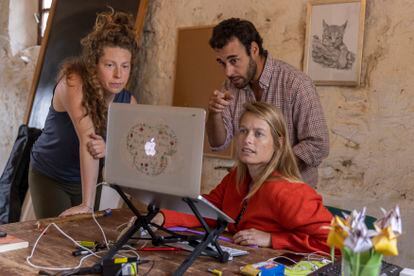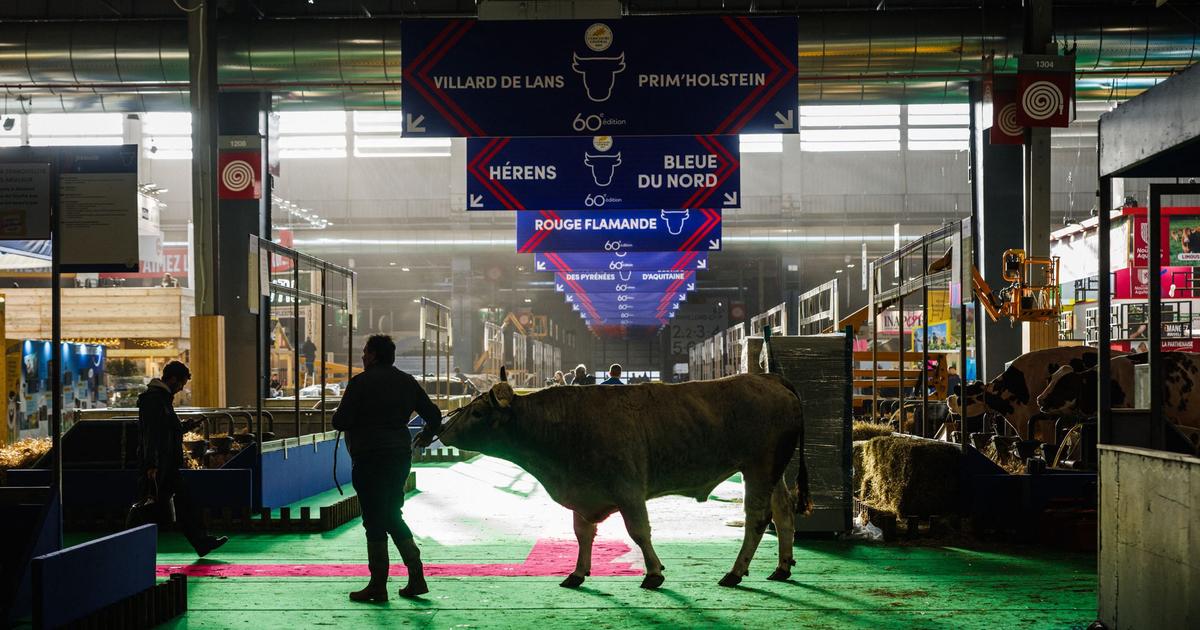In the Murcian highlands, in Caravaca de la Cruz, at an altitude of 1,100 metres, the cereal crops cover, drawing grids, some poor fields that are hard to crack for the farmer.
From the road you can see the extreme aridity of the area, one of the most desertified in Europe, with extreme weather and scarce but torrential rains.
At the end of an unpaved road, on a small elevation, there are some dilapidated buildings and an open gate, the gateway to La Junquera, the epicenter of the Regeneration Academy project.
The 1,100-hectare estate is dedicated to regenerative agriculture, a farming system that, in addition to being ecological, promotes the recovery of the soil from which conventional and intensive agricultural practices have extracted all life,
destroying the organic matter formed by millions of microorganisms.
This destruction also takes away its ability to store carbon dioxide, the main greenhouse gas responsible for climate change.
La Junquera exudes youth and determination.
Those responsible for the project firmly believe that the future of agriculture and the food system involves producing without overexploiting the land and without destroying biodiversity.
“But we are not denying the tractor, it is not about going back to the past, but about using technology in a rational way and generating a profitable economic activity that has an impact on the local community”, explains Jacobo Monereo, economist and director of the project.
La Junquera was dedicated to conventional wheat monoculture until in 2011 Alfonso Chico de Guzmán, a graduate in Business Administration from Boston, moved to this farm owned by his family for two centuries with a different business vision.
In 11 years they have diversified production and cultivate cereals, almond trees, pistachios, aromatic plants, vines or apple trees and garden products, always with techniques focused on soil restoration.
Agricultural practice is linked to activity in the academy itself, in which students, professionals, researchers and entrepreneurs contact regenerative agriculture and provide feedback to the project with their contributions.
The circle is completed with the Camp's volunteers, who train and help with the work.
On the farm they recover the cows of the Murcian Levantine breed.
Ana Palacios
Ferdi Ernest, a 63-year-old French pensioner, and Clemence Zeegers, an 18-year-old Belgian student, are two of the volunteers collaborating with the project.
It is not the first time they visit the farm.
Ernest stayed for a month last November and Zeegers met her three years ago, when she came with her parents.
Sitting at a rustic wooden table, next to the cabin where they live, they recount the experience with enthusiasm.
They are amazed at the change.
“Before there was nothing here, now herbs, flowers, almond trees have grown…”, she explains, while looking around.
They help and at the same time learn, planting and taking care of the garden.
According to his account, Ernest came into this world “by chance”.
Two years ago, on a trip to Uganda, he met John D. Liu, an American filmmaker, environmentalist, and researcher who founded Ecosystem Restoration Camps, a global movement that aims to restore damaged ecosystems on a large scale.
“We traveled together and I thought this could be very interesting;
I enrolled in a nine-month course and here I am”, he explains with a smile.
They live without comfort, but he says it's worth it.
"We want to do something important for the world," responds Inés Lappe, a 25-year-old German biologist who met her partner in another similar project.
Sanne Kruijt, Yanniek Schoonhoven and Jacobo Monereo, responsible for the Regeneration Academy.
Ana Palacios
The model they follow consists of tilling the land as little as possible so as not to break the roots, thus avoiding the deterioration of organic matter and achieving an increase in biodiversity;
in improving the use of water and in the substitution of agrochemicals of synthetic origin by compost or by cattle droppings.
This would be the case of the sheep owned by a shepherd in the area with whom La Junquera agreed that the ruminants would feed on it in exchange for a payment, "literally in shit," explains Monereo.
It is the perfect combination of livestock with agriculture, for which they also use the 25 cows of the Murcian-Levantine breed, of which there are only about 40 copies left, which they are trying to recover.
Water management is essential: "Here not a drop falls for seven months and suddenly 150 liters arrive in an hour and destroy everything," says Monereo.
They estimate that there is a loss of soil of about 20 tons per hectare per year and in some areas of up to 80 tons.
"This affects the crop, because the first 20 centimeters are lost, which is where the fertile part of the soil is found," he adds.
To avoid this, they experiment with infiltration strips that slow down the speed of the water and favor its retention.
And in recent months they have planted 10,000 trees, which reduce erosion, in collaboration with Life Terra, a project co-financed by the European Union.
Not everything has been a bed of roses.
The houses in the district of La Junquera, abandoned by their inhabitants in the sixties, were in very poor condition, and the first attempt to produce organic vegetables, which Chico de Guzmán planted "in a piece of the garden", failed.
“Cold transportation was very complicated;
I also tried distributors, but it didn't work”, clarifies the founder of the project, who always had in mind “to end up in the field sooner or later”.
He has achieved it.
He lives in one of the remodeled houses with his wife, Yanniek Schoonhoven, a graduate in Environmental Sciences and director of the project, and his two children.
Chico de Guzmán is proud that 14 people usually reside in the small district, in addition to another 20, including students from the different courses they teach and the volunteers of the Camp,
Julia Casado, oenologist, artisan vintner and agricultural engineer, playing the cello on the farm.
Ana Palacios
Julia Casado, wine producer, cellist and agricultural engineer, has chosen La Junquera as the base for her company.
She started in 2016 with her “small artisanal and natural wine business” and a reduced budget that forced her to “sharpen her wits”.
She rented some vineyards and designed a small 66 square meter transportable warehouse.
When her lease ran out, she was offered to move to La Junquera.
“It was far from the vineyards, about 45 kilometers away, but I was very lonely and we had hit it off,” she says.
“We help each other, here there are projects, dynamism, they have proposed me to associate with other people and I also propose actions;
for example, they have planted a vineyard with my advice.
It is a life project”, she explains.
Julia Casado produces between 20,000 and 30,000 bottles and exports wine to 14 countries,
with destination from New York and London to Tokyo, but it is more complicated for him to introduce his product in the area.
Where they can be tasted is at El Celler de Can Roca, the Roca brothers' three-Michelin-starred restaurant in Girona.
Casado does not come from a family of winegrowers, but he discovered “natural wines that can be described as a message in a bottle that connects you with the territory, just like music”.
“This house was abandoned”, explains Íñigo Flores, while showing the already inhabitable house and apologizing for the mess.
This artist from Madrid, childhood friend of Alfonso Chico de Guzmán, landed in La Junquera two and a half years ago when he touched “the ceiling, because he needed something more”.
For him, the farm is a “place of creation”.
In his work he uses medieval blacksmithing techniques that he learned in Salamanca, where he trained as an apprentice blacksmith.
He enjoys "using the bellows to reach the melting temperature of iron and from there to manufacture everything from livestock and agricultural tools to sculptures and street furniture."
On the farm, one of his works, which represents a juniper from the island of El Hierro, is planted in front of the crops.
The artist Íñigo Flores working with iron in the forge to create one of his works. Ana Palacios
In the development of Regeneration Academy, the AlVelAl association has played and plays a fundamental role, a project to restore the landscape of the steppe plateau that extends over a million hectares in inland areas of Almería, Granada and Murcia.
This is the place in the world with the largest area of high-quality rain-fed almond trees, 100,000 hectares, 50% certified organic, as indicated by the data it provides.
The association brings together 200 farmers and ranchers, whom it supports in the transition to the regenerative model by preparing a diagnosis of the farm and with financing.
They are going to start up a bank of shared machinery and have a series of indicators to check if the method is working on the farms.
Santi Sánchez Porcel is one of the farmers who have chosen to change the way of production in her 56 hectares of almond trees, 60 of cereals and legumes, and in the management of her 700 sheep of the southern breed.
Her property is located in the municipality of Chirivel, in the north of Almería.
"I am very clear that the floor is life support," she insists.
This was not always the case, they began to implement regenerative techniques in the early nineties without being aware of it, simply because they needed feed for the cattle.
They solved it by planting between the alleys that separate the almond trees a mixture of cereals and legumes that they call “green manures”.
The cattle eat it and they also put it in the ground.
“This way, for five or six months of the year, we have like a big sponge that gets soaked when it rains and runoff stops and erosion is reduced,” he explains.
They realized the importance of the measurement when the AlVelAl association carried out an analysis of the soil.
“It turns out that we were doing something useful and good that even had a name,” he recalls.
“There was a time when farmers of our generation [Santi is 55 years old] thought we were very smart;
With large tractors and good implements, we came to the top and began to produce more and at a higher speed”, he recalls.
Until they realized that “our elders, although they did not have as much training, were wiser”.
They also had tractors, but smaller ones, and the 6-inch plow didn't break the ground.
Santi is now very clear about the techniques to be applied: favor the creation of organic matter, prevent the loss of fertile soil and increase biodiversity.
In his case, the investment was affordable by having AlVelAl, which grants funds every year to acquire the seeds and seedlings that will grow among the almond trees.
He has even done well, because "we are marketing our products from year one,
and the almond, which is our golden nugget, is sold at a higher price because, although there is no regenerative agriculture certification, buyers know how they grow.”
What Santi had the most trouble with was convincing her partner of hers, since “the change of mentality is the most complicated”, he acknowledges.
He is now at the next stage: showing farmers "with papers in hand" the advantages of returning to the earth everything that has been taken from it.
A student of the research program in one of the ponds of La Junquera.
Ana Palacios
Marc Gràcia, a scientist at the Center for Ecological Research and Forestry Applications (CREAF) of the Autonomous University of Barcelona, agrees that changing thinking is difficult and affirms that the transformation will only occur when farmers and consumers are convinced that “ we produce not only to obtain a harvest, but to feed the life of the soil”.
The researcher has been engaged for five years in the restoration of an abandoned farm in Girona with regenerative agri-food techniques.
“The challenge is to achieve a profitable model from which quality food is obtained for everyone.
Otherwise, it doesn't work,” he warns.
On the Planelles farm they have managed to produce the basic food for 200 families, without agrochemicals and going from an amount of organic matter from 1.8% to 6% in the soil.
This does not mean that the same results are obtained in all places, it depends on the type of terrain, the climate and other parameters.
"The complexity of the soil," he adds, "is extraordinary and we do not know even a tiny part of something that is the basis of life on Earth, a world that depends in turn on the most visible biodiversity [plants, insects, birds ]”.
Agriculture has taken resources from that infinite warehouse that is the soil to give them to plants.
In the beginning, there were few crops and nature was recovering, ”he explains.
With the green revolution at the beginning of the last century, "the warehouse was emptied, the land became a pure support and what was previously carried out by roots, bacteria, fungi, worms..., was replaced by plowing the land at great depth. , breaking down the house of all that life, and also with the use of agrochemicals”, adds Marc Gràcia.
The regenerative method "does not come from universities or research centers, but from the experience of farmers who have gone through bad times," he says.
It is not something new, and “although more attention is beginning to be paid to it, it continues to be marginal”, concludes Gràcia.














